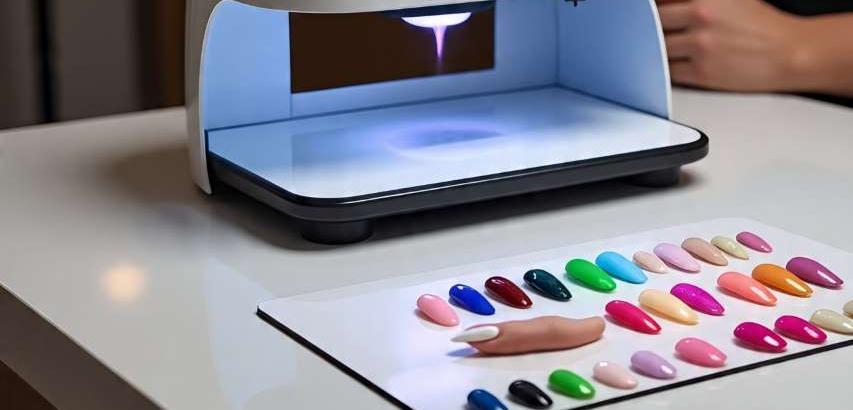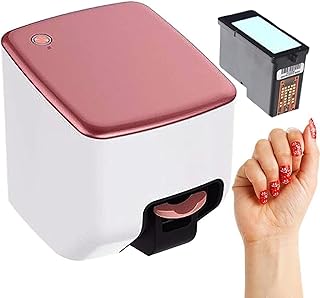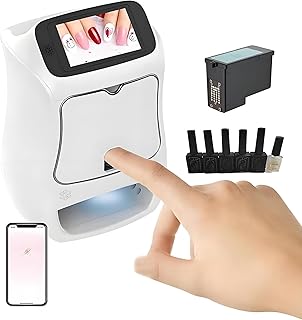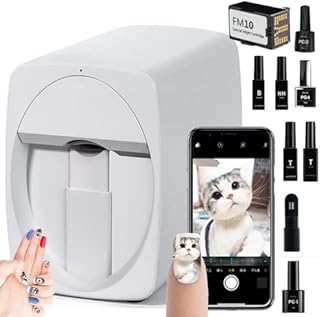
A Digital Manicure Printing Machine is a sophisticated device that applies high-resolution artwork directly onto human fingernails and toenails. It represents a monumental leap in beauty technology, transforming the nail industry by making intricate, salon-quality designs accessible, consistent, and incredibly fast. It moves nail art from a painstaking, hand-painted craft to a precise, digital printing process.
How It Works: The Process from Concept to Nail
The operation of a digital nail printer can be broken down into a few key steps, combining hardware, software, and chemistry:
Preparation: The client's nails are prepared as for a traditional manicure: shaped, buffed, and cleaned. A base coat is applied. Crucially, this base coat is almost always pure white. This acts as a primer and a "canvas," ensuring the colors of the digital print appear vibrant and true, much like white printer paper.
Positioning: The client places their finger(s) onto a dedicated platform or into a booth within the machine. Advanced models use automatic finger positioning with adjustable grips to ensure stability and perfect alignment.
Scanning & Mapping: This is a critical technological step. The machine does not simply take a picture.
A high-resolution camera or 3D scanner captures the exact shape, curvature, and boundaries of the nail.
Proprietary software algorithms then create a precise 3D map of the nail's surface. This ensures the printer head knows exactly where to deposit ink, avoiding the skin and cuticles for a perfectly clean application every time.
Design Selection & Software Editing: The user (stylist or client) selects a design from a pre-loaded library or connects the machine to a computer/tablet to upload a custom image (e.g., a logo, photograph, or complex pattern). The software allows for resizing, rotating, and positioning the design on a virtual model of the scanned nail.
Printing: The core of the machine is a highly precise, micro-scale print head (similar to those in an inkjet printer but far more advanced).
The print head moves over the nail, depositing tiny droplets of specially formulated nail ink directly onto the surface.
It prints the design layer by layer, in full color, with incredible detail, achieving resolutions that can exceed 500 dpi (dots per inch).
Curing & Sealing: Immediately after printing, the nail is exposed to a built-in UV or LED lamp. This instantly cures and dries the inks, making them smudge-proof. Finally, a clear top coat is applied by the technician and cured again to seal the design, add shine, and ensure longevity.
Key Components and Technologies
Print Head: The most crucial component. It uses piezoelectric technology to precisely control the ejection of ink droplets. It must be extremely accurate to handle the tiny, curved surface of a nail.
Specialized Inks: These are not ordinary printer inks. They are non-toxic, skin-safe, and formulated to adhere to the nail's surface. They are also vibrant and fast-curing under UV/LED light. The standard ink set is CMYK (Cyan, Magenta, Yellow, Black), which can be combined to create millions of colors.
3D Scanning System: This sets it apart from a regular printer. The ability to map the unique topography of each nail is what allows for a flawless, mess-free application without stencils or guides.
Software: The brain of the operation. It processes the scan, hosts the design library, allows for image manipulation, and translates the final design into printing instructions for the print head.
Advantages and Benefits
Unmatched Detail and Complexity: It can print photorealistic images, intricate patterns, gradients, and brand logos that are virtually impossible to achieve by hand.
Speed and Efficiency: A complex, ten-nail design can be printed in minutes, drastically reducing the client's time in the chair compared to lengthy hand-painting sessions.
Consistency and Perfection: Every nail is identical. The machine eliminates human error, shaky lines, and smudging. The result is perfectly aligned and sharp every time.
Hygiene: Many machines feature automatic cleaning cycles for the print head to prevent ink contamination and ensure sanitary operation between clients.
Customization: The possibilities are endless. Clients can have their own photos, favorite artwork, or company branding printed directly onto their nails.
Limitations and Considerations
Cost: The initial investment for the machine and the proprietary inks is significant, making it primarily a tool for professional salons and high-end spas.
Nail Shape Limitations: The technology works best on nails with a relatively flat curve and a sufficient surface area. Very short, highly curved, or deeply sculpted nails may present challenges for the scanner and print head.
Base Coat Requirement: The necessity of a white base coat can be a limitation for those seeking a completely transparent or "barely-there" look with simple designs.
Maintenance: Like any precision instrument, it requires regular maintenance, cleaning, and occasional print head replacements to function optimally.
The Future of Nail Art
The digital manicure printer is more than a gadget; it is a transformative technology that democratizes high-end nail art. It empowers salons to offer a previously unimaginable service, attracting clients seeking unique, personalized, and perfect designs. While it will not replace the artistic skill of a talented nail technician for all styles (like 3D nail art or sculpting), it has carved out a dominant and growing niche. It represents the seamless fusion of beauty and digital innovation, pushing the boundaries of self-expression in the cosmetics industry.
 |  |  |
 |  |  |